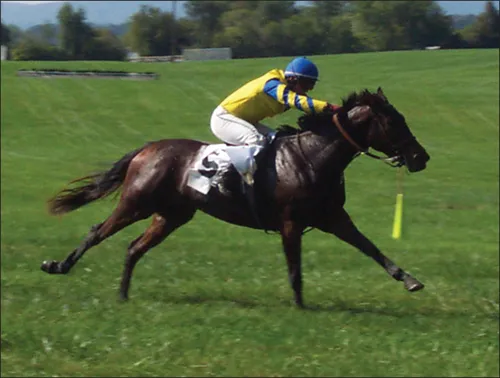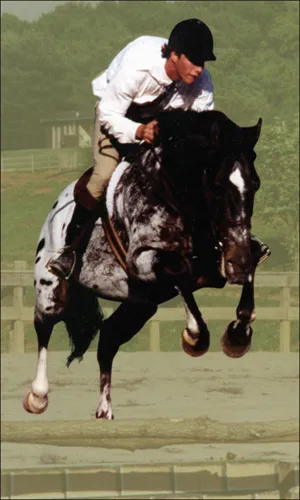
eBook - ePub
Broodmare Reproduction for the Equine Practitioner (Book+CD)
William Ley
This is a test
Buch teilen
- 250 Seiten
- English
- ePUB (handyfreundlich)
- Über iOS und Android verfügbar
eBook - ePub
Broodmare Reproduction for the Equine Practitioner (Book+CD)
William Ley
Angaben zum Buch
Buchvorschau
Inhaltsverzeichnis
Quellenangaben
Über dieses Buch
A concise and liberally illustrated working guide on Broodmare health and breeding management for veterinarians, veterinary students and breeders. The presentation includes all of the clinical procedures and assessments necessary for maintaining the health and breeding soundness of the Broodmare. This handy reference covers the use of ultrasonograp
Häufig gestellte Fragen
Wie kann ich mein Abo kündigen?
Gehe einfach zum Kontobereich in den Einstellungen und klicke auf „Abo kündigen“ – ganz einfach. Nachdem du gekündigt hast, bleibt deine Mitgliedschaft für den verbleibenden Abozeitraum, den du bereits bezahlt hast, aktiv. Mehr Informationen hier.
(Wie) Kann ich Bücher herunterladen?
Derzeit stehen all unsere auf Mobilgeräte reagierenden ePub-Bücher zum Download über die App zur Verfügung. Die meisten unserer PDFs stehen ebenfalls zum Download bereit; wir arbeiten daran, auch die übrigen PDFs zum Download anzubieten, bei denen dies aktuell noch nicht möglich ist. Weitere Informationen hier.
Welcher Unterschied besteht bei den Preisen zwischen den Aboplänen?
Mit beiden Aboplänen erhältst du vollen Zugang zur Bibliothek und allen Funktionen von Perlego. Die einzigen Unterschiede bestehen im Preis und dem Abozeitraum: Mit dem Jahresabo sparst du auf 12 Monate gerechnet im Vergleich zum Monatsabo rund 30 %.
Was ist Perlego?
Wir sind ein Online-Abodienst für Lehrbücher, bei dem du für weniger als den Preis eines einzelnen Buches pro Monat Zugang zu einer ganzen Online-Bibliothek erhältst. Mit über 1 Million Büchern zu über 1.000 verschiedenen Themen haben wir bestimmt alles, was du brauchst! Weitere Informationen hier.
Unterstützt Perlego Text-zu-Sprache?
Achte auf das Symbol zum Vorlesen in deinem nächsten Buch, um zu sehen, ob du es dir auch anhören kannst. Bei diesem Tool wird dir Text laut vorgelesen, wobei der Text beim Vorlesen auch grafisch hervorgehoben wird. Du kannst das Vorlesen jederzeit anhalten, beschleunigen und verlangsamen. Weitere Informationen hier.
Ist Broodmare Reproduction for the Equine Practitioner (Book+CD) als Online-PDF/ePub verfügbar?
Ja, du hast Zugang zu Broodmare Reproduction for the Equine Practitioner (Book+CD) von William Ley im PDF- und/oder ePub-Format sowie zu anderen beliebten Büchern aus Medicina & Medicina veterinaria. Aus unserem Katalog stehen dir über 1 Million Bücher zur Verfügung.
Information

Section 1
Equine Reproductive Efficiency


General Principles
The primary goal of this book is to provide a useful and concise reference on broodmare reproduction and breeding management for veterinarians and veterinary students. An attempt is made here to present key features and facts in a concise format, but the practice of veterinary medicine, and most especially equine reproduction, is also an art. Practicing an art and being competent, as well as successful, requires years of practical experience. Do not become discouraged in your attempts that may prove disheartening, learn from them. Remembering always that you are dealing with nature, and one of its more complex biological systems. Try as we might, recipes, formulas, definitions, rules, guidelines, expectations, and methods of therapy do not always work or apply in every circumstance or situation. Be creative, find the beauty in procreation, and always seek to learn.
Some Helpful Hints
Scattered throughout the text, you will find the following symbols to help you focus on what is routine and what may be really important:
| ✓ | This is a routine feature or basic point for understanding the subject discussed. |
 | The key symbol will be used selectively to indicate a very important point to assist your understanding of the topic area. |
 | Stop. This does not look important, but it can really make a difference when trying to sort out unusual or difficult situations. It can be my opinion based on personal experience. |
 | Something serious will happen if you do not remember this, possibly resulting in injury or loss to the patient, and upset to the client. |
| ⊙ | A companion CD is available for purchase by calling 877-306-9793. The CD contains the full text, figures, and tables of this book formatted for easy search and retrieval. The CD symbol indicates that additional images and video of a topic are available on the CD or a hyperlink reference for further reading. |
Success in equine reproduction depends on a solid understanding of reproductive anatomy, physiology, endocrinology, breeding management, disease prevention and treatment as indicated, and the maintenance of complete and accurate records.
An understanding of optimal reproductive efficiency in the horse serves as a sound basis for communicating with clients the expected normal. Having this understanding makes the identification of abnormal performance much easier.
Definitions
✓ Fertility: the quality or state of being fertile, which means producing or being capable of producing offspring; it implies the power or ability to reproduce in kind or to assist in reproduction and growth.
A mare with appropriate anatomic, physiologic, and endocrine structure and function has the ability or implied power to reproduce. She by definition then would be considered fertile. But she may be terribly inefficient at the task given loss, damage, injury or disease to an integral anatomic structure, or a dysfunction in her underlying reproductive physiology. It is therefore preferable to avoid defining the mare’s ability to reproduce as either fertile or infertile. A mare that has undergone bilateral ovariectomy can effectively be used as an embryo transfer recipient mare and therefore has retained the ability to reproduce in kind. She must by definition be considered fertile, yet has no inherent ability remaining to conceive on her own.
✓ Efficiency: the quality or degree of being efficient, which means productive of the desired effect, especially productive without waste.

It would be agreed to by many that an 8 year old mare is likely to be more efficient at producing an offspring than a 24 year old mare. Both are, or have the likelihood of being, fertile. Many 24 year old mares produce live offspring, yet their efficiency at the task is considerably much less than that of the 8 year old mare. The younger mare typically requiring much fewer resources in terms of labor, time, pharmaceuticals, and breeding attempts to achieve conception and gestate her fetus to full term than the older mare.
✓ Soundness implies an ‘absolute’ understanding, which when used for the purpose of a mare’s breeding soundness examination, is potentially misleading. Its use should be avoided in this context, as it is extremely difficult, if not impossible, to absolutely state from an examination that a mare without reservation can and will conceive and carry her fetus to full term. The likelihood may exist; there may be no findings to indicate any other probable outcome than success, but a likelihood and a probability are not absolute.
✓ Suitable is a ‘term of art’ and refers to temperament, ability, and relationship of the horse to rider, driver, exhibitor or other desired use. While a breeding suitability examination may be more useful terminology, it is not entirely appropriate for the veterinarian to pass judgement on suitability with respect to the mare’s genetics for breeding purposes.

Reproductive efficiency and breeding serviceability in the mare therefore require the presence of normal and functional anatomic reproductive tract components with reasonable physiologic function. These performing as nature intended enable her to undergo regular estrous cycles, exhibit estrous behavior, ovulate a normally matured ovum (ova), and transport the ovulated ova to the site of fertilization. She must have the uterine environment to support or allow normal sperm transport at breeding time and sperm capacitation following semen deposition. The viable ovum in the appropriate environment and timing with viable capacitated spermatozoa then set up the opportunity for conception to occur. The mare’s uterine environment must then have the ability to recover from the challenge of breeding or insemination in time to receive the conceptus or embryo 6-8 days after fertilization. The mare must recognize that she is indeed pregnant, and sustain in utero embryonic and fetal growth, cooperate effectively with placental growth, function and development, and have the anatomic ability to produce a viable offspring by spontaneous unassisted vaginal delivery. She must further be capable of supporting her foal’s extrauterine growth through lactation for a defined period of time until weaning. During the immediate postpartum time, and while lactating, she must also involute the uterus, cycle again, be receptive to breeding, and conceive again for the following year’s production of offspring. How serviceable for such events and how efficiently she can perform them are dependent upon a multitude of factors. Factors which in a natural environment (e.g., pasture breeding) can come together making her wonderfully efficient. Under the influences of domestication, husbandry, and breeding management (e.g., breeding in hand) she can become very inefficient.
✓ Maiden: a mare that has never been bred or exposed to a stallion for breeding purposes. It usually implies a young mare, but many mid- to late-teenage mares used in performance may also fit into this definition. Young maiden mares having gone through puberty are typically the most reproductively efficient.
✓ Lactating: a mare that has ‘proven’ herself, has a foal at her side, and is lactating; the result of having recently conceived, successfully gestated, and foaled. She may also be referred to as a ‘wet’, foaling, or postpartum mare. They are most typically reproductively efficient, but advancing age or foaling injury may make them less likely to conceive and produce another offspring in the next 12 months.
✓ Barren: a mare that has failed to conceive in the most recent breeding season, or one more distant and not since. She may have conceived, been confirmed as pregnant, and then subsequently aborted, or had a stillbirth, and fit into the barren category. Key to this is having had the opportunity to conceive and carry to term, yet has failed to do so. They are therefore less reproductively efficient than the preceding two groups of mares.
Rates, Terms, and Efficiency
✓ The best measure of breeding performance is the live foal crop. This is defined as the proportion of the number of live healthy foals produced compared to the number of mares maintained for breeding in a given season or period of time. The most widely used basis (i.e., denominator) for calculating the live foal crop is the number of mares actually bred or having had the opportunity for exposure to a reproductively fit or efficient stallion (or his spermatozoa). On the basis of mares bred, the live foal crop should be 75-80%.
✓ The proportion of mares slated for breeding that are not...